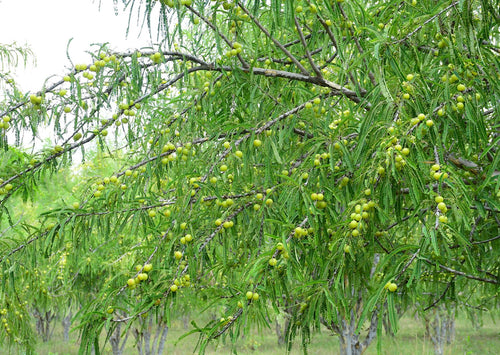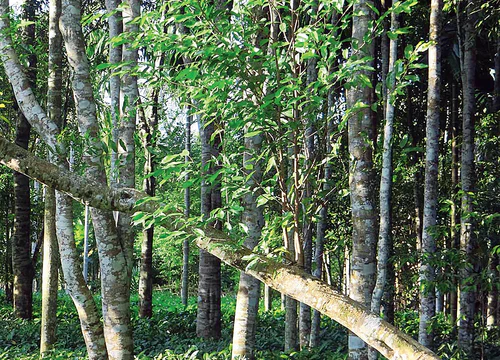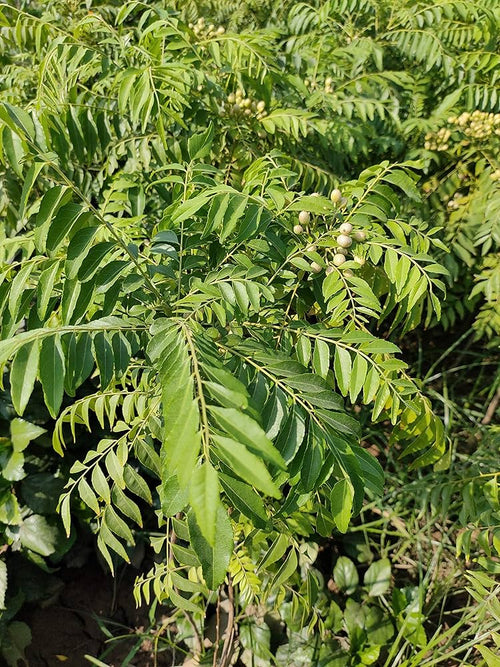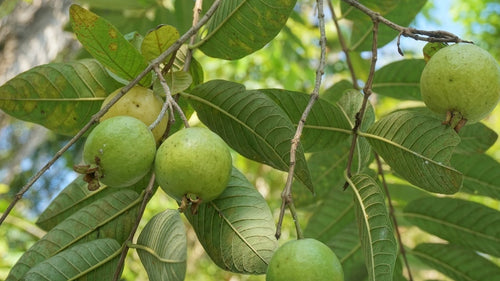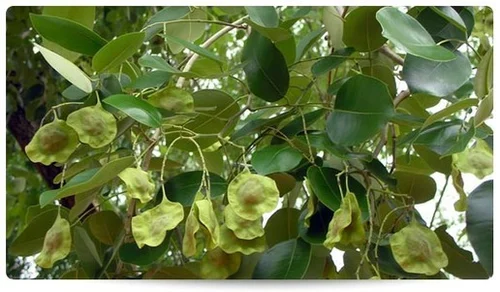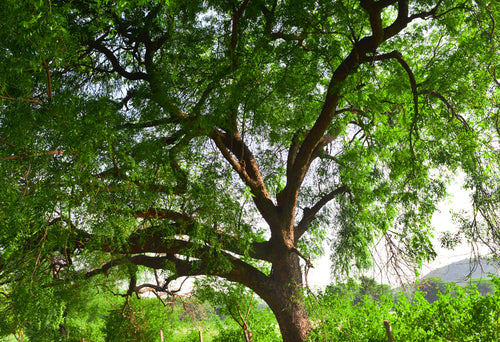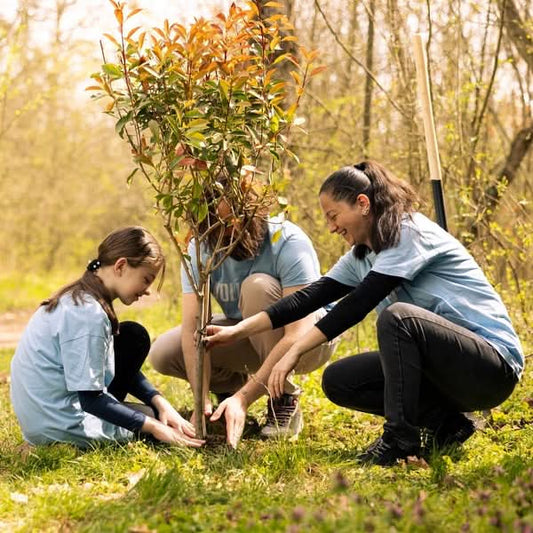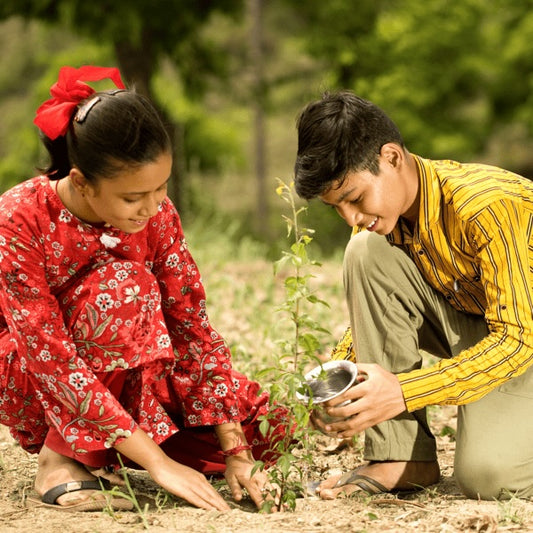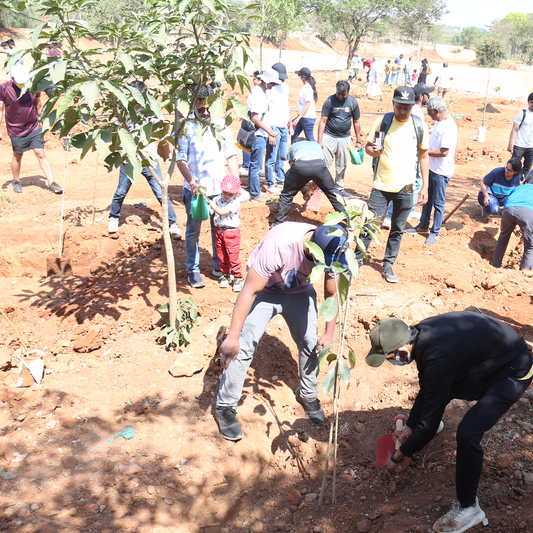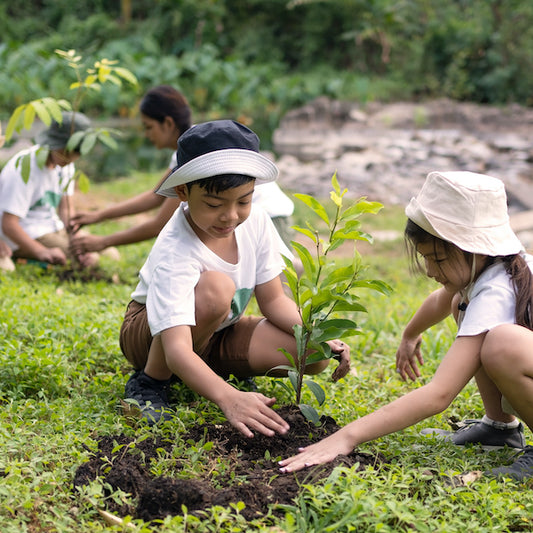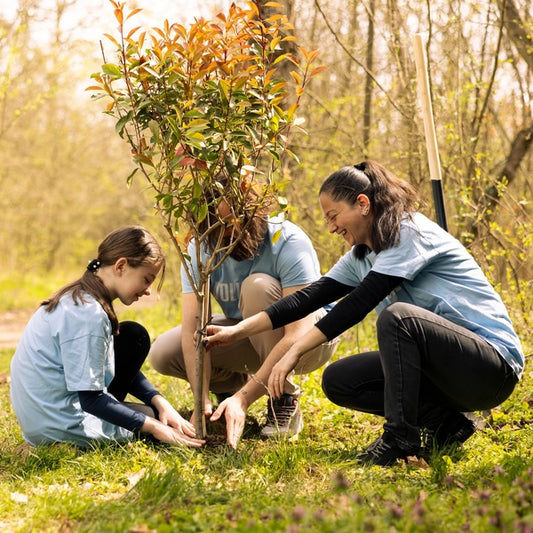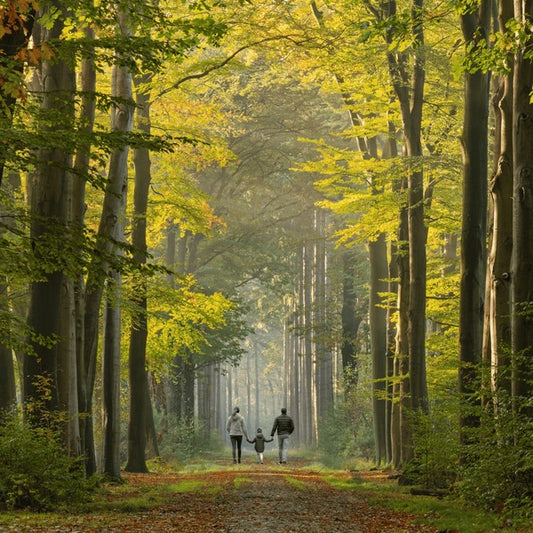Caterpillar's Centennial Legacy: A Thriving Learning forest in Chennai
Caterpillar has long been a global leader in innovation and engineering, driving progress and transforming industries for over a century. Its flagship Read more
Project Update 3

Project Update 2




Project Update 1





Digital Forest
Forest with 2,000 Trees planned
Want to plant your tree now?
Plant a Tree @ 299Caterpillar's Centennial Legacy: A Thriving Learning forest in Chennai Nandanam
Caterpillar has long been a global leader in innovation and engineering, driving progress and transforming industries for over a century. Its flagship brand, Cat, is synonymous with quality, reliability, and resilience values that extend beyond machinery and engines to reflect a strong, ongoing commitment to sustainability. More than just a symbol of equipment, the Cat logo represents hard work, determination, and a resilient spirit, values that Caterpillar is now channeling into environmental stewardship.
In celebration of its 100-year milestone, Caterpillar has launched a large-scale afforestation initiative involving the plantation of 50,000 native saplings across 13 schools in Chennai, Thiruvallur, and Hosur. This transformative effort aims to create sustainable green spaces within educational institutions, fostering both ecological restoration and environmental awareness among students.
This initiative marks the establishment of a "Learning Forest," an innovative green space designed to integrate ecological restoration with environmental education. By creating living, breathing forests within school campuses, the project nurtures a hands-on learning environment where students can explore biodiversity, climate action, and sustainability in real time.
The plantation at Government Model Higher Secondary School, Nandanam, Chennai is a location under this initiative and involves the plantation of 2,000 native saplings using the Miyawaki afforestation technique. This dense, fast-growing forest will not only enhance the local ecosystem but also serve as a powerful educational tool, inspiring students to actively participate in environmental conservation.
The learning forest will also act as a natural green barrier, reducing noise pollution, regulating the climate, and fostering biodiversity by attracting birds and pollinators. Its impact extends beyond tree planting, it transforms the environment, creating a thriving ecosystem within the school premises.
Additionally, students will have hands-on involvement in tracking tree growth, measuring carbon absorption, and studying ecosystem development. This initiative blends classroom learning with real-world climate science, encouraging young minds to become environmental champions.
Through this project, Caterpillar reinforces its signature get-it-done attitude—this time, in service of the planet. As the company continues to build a better world, its efforts go beyond engineering machines to cultivating forests, nurturing knowledge, and shaping a more sustainable future.
Project Planning & Execution
No of Trees: 2,000
Plantation Location: Government Model Higher Secondary School 26HV+3QJ, 1st Main Rd, Nandanam Extension, Nandanam, Chennai, Tamil Nadu 600035
Plantation Date: 21st June 2025
Names of Species: Indian kino tree, Rosewood, Arjuna tree, Pungamia, Orchid tree, Paradise tree, Neem, Guava, Custard apple tree, Amla tree, Henna, Hibiscus, Golden trumpet, Indian oleander, Jasmine, Night Jasmine, Indian borage, Physic nut, Pinkwheel flower
Species Selection & Its Benefits:
The species selected for Caterpillar’s Learning Forest initiative at Government Model Higher Secondary School, Nandanam, Chennai, were carefully chosen to align with the local ecosystem and maximise ecological and educational impact. A total of 2,000 trees were planted, featuring a diverse mix of native species across Canopy, Tree, Shrub, and Ground layers—each contributing to the creation of a dense, resilient, and biodiverse forest using the Miyawaki method.
The selection includes the following: Indian Kino Tree (Vengai) is valued for its strong timber and medicinal gum; Rosewood (Eeti) provides durable hardwood and supports biodiversity; Arjuna Tree (Marutham) is known for its bark’s heart health benefits and erosion control. —long-living canopy and emergent species known for their role in carbon sequestration, climate regulation, and habitat creation for birds and beneficial wildlife. These form the forest's structural backbone, promoting long-term climate resilience and ecological balance.
Pungamia (Poongai) is a fast-growing, nitrogen-fixing tree known for improving soil fertility and producing seeds useful in biofuel and traditional medicine. Orchid Tree (Mantharai) is appreciated for its attractive, medicinal flowers and shade-providing canopy. Paradise Tree (Sorgam) helps repel pests and improves air quality, while Orchid Tree(Vembu) is renowned for its powerful antibacterial, antifungal, and insect-repellent properties, widely used in agriculture and Ayurveda. Amla (Mullu Nelli) is rich in antioxidants and supports immunity, digestion, and skin health. Henna (Maruthani) is traditionally used for natural dyeing, cooling the skin, and treating minor skin conditions.
Fruit-bearing trees like Guava (Goiya) and Custard apple(Seetha) not only provide highly nutritious, fiber- and vitamin-rich fruits but also support pollinators and enhance biodiversity. These trees contribute to food security, local livelihoods, and environmental sustainability when included in plantation drives.
Shrubs like Hibiscus (Sembaruthi), Golden Trumpet (Almanda), Indian Oleander (Arali), Jasmine (Malli), Night Jasmine (Parijatham), and Physic Nut (Jetruba) are widely valued for their ornamental and medicinal properties. Hibiscus is commonly used in hair and skin care remedies and attracts pollinators. Golden Trumpet adds bright yellow blooms to landscapes and helps improve air quality. Indian Oleander, though toxic, is traditionally used in small doses for heart-related ailments and is valued for its beautiful flowers. Jasmine is known for its strong fragrance, cultural significance, and use in oils and teas. Night Jasmine blooms at night and is used in Ayurvedic medicine to treat fever, joint pain, and skin issues. Physic Nut is drought-resistant, acts as a natural pest repellent, and is useful in biofuel production.
Indian Borage (Karpuravalli), a soft-stemmed herb, is well-known in traditional medicine for treating coughs, colds, and digestive disorders due to its aromatic and antimicrobial properties. Pinkwheel Flower (Nanthitatvatam), a dense, spreading ground cover plant, is often used for hedges and erosion control. It is hardy, salt-tolerant, and helps retain soil moisture, while also offering mild medicinal benefits. These plants collectively offer a range of ecological benefits—improving soil health, supporting pollinators, offering shade and shelter for small fauna, and providing traditional medicinal value in home gardens and green spaces.
This thoughtfully curated mix of species ensures rapid forest development while encouraging ecological learning and stewardship. The Learning Forest at Sevvapet not only revitalises an underutilised space but also empowers students and the wider community to actively participate in nurturing a greener, healthier future.
Beneficiaries Details
-
Target Population: Employees, stakeholders, students, and staff of the Government Model Higher Secondary School Nandanam, Chennai
-
Age Group: Inclusive of all age groups, ensuring broad community participation.
-
Gender: Inclusive of all genders.
-
Social & Economic Status: Open to all social and economic backgrounds, emphasising community involvement.
Planting Methodology and Its Advantages
Miyawaki Technique: The Miyawaki technique is a dense afforestation method that promotes rapid green cover using native plant species. It consists of rapidly growing vegetation that develops 10 times faster and becomes 30 times denser than conventional plantations. By closely planting a diverse mix of flora, it creates a self-sustaining ecosystem that requires minimal maintenance. This method enhances biodiversity, improves air quality, absorbs carbon dioxide, and restores degraded land. Due to its high-density plantation style, it is especially effective in urban areas, offering environmental benefits such as temperature regulation, noise reduction, and soil enrichment.
Four-Step Process of Planting a Miyawaki Forest:
1. Preparation and Analysis
- Site Analysis: Begin with a thorough analysis of the site, considering factors like soil type, water availability, and sunlight exposure. This analysis guides the selection of native plant species best suited for the location.
- Soil Preparation: Clear the area of weeds and debris. Loosen the soil by tilling and amend it with organic compost to enhance fertility and moisture retention.
2. Plant Selection and Planting
- Plant Selection: Choose native plant species that are fast-growing, drought-resistant, and indigenous to the region. Diversity is crucial to mimic natural forests and promote ecological balance.
- Planting Technique: Dig pits or trenches for planting saplings, ensuring each has enough space to grow. Plant at a high density, typically 3 to 5 times denser than traditional forests.
3. Care and Maintenance
- Mulching: Apply a thick layer of mulch around the saplings to suppress weeds, conserve moisture, and protect the soil from erosion. Mulch also enriches the soil as it decomposes.
- Watering: Initially, saplings need regular watering to establish their roots. Once established, they require less frequent watering, but regular monitoring remains essential.
4. Monitoring and Growth
- Regular Maintenance: Perform regular weeding, pruning, and pest control during the initial years. Miyawaki forests become self-sustainable as they mature but still require occasional maintenance.
- Monitoring: Keep track of the forest's growth and health, monitoring for signs of stress, disease, or pest infestations and taking timely action when needed.
Four Layers of a Miyawaki Forest
The Miyawaki method emphasizes creating a multi-layered forest that mimics natural forests to achieve rapid growth and high biodiversity. Here are the four layers typically found in a Miyawaki forest:
- Canopy Layer: This topmost layer consists of tall trees that provide the canopy. These trees are usually fast-growing species that can reach heights of 15 to 30 meters or more. They offer shade and protection to the layers below.
- Tree Layer: Beneath the Canopy layer is the tree layer, consisting of smaller trees and larger shrubs. These plants help fill in the gaps between the taller trees, contributing to the dense foliage that characterizes a mature forest.
- Shrub Layer: Below the canopy, the shrub layer includes smaller shrubs and bushes that provide additional structure and diversity to the forest. These plants play a vital role in attracting pollinators and providing habitat for various wildlife.
- Ground Layer: The lowest layer is the ground layer, comprising ground covers, ferns, and herbaceous plants. These plants help to retain moisture, suppress weeds, and protect the soil. They also contribute to the overall biodiversity by providing habitat for insects and microorganisms.


Each layer in a Miyawaki forest serves a unique purpose and contributes to the forest's resilience, biodiversity, and ecological functionality.
Advantages of the Miyawaki Technique
-
Faster Growth: Vegetation grows up to 10 times faster than conventional methods due to high-density planting, soil conditioning, and native species selection. It reaches maturity in 20-30 years instead of over a century, making it highly effective for ecological restoration.
-
Biodiversity Enhancement: The technique encourages a diverse mix of native species, supporting wildlife such as birds, insects, and small mammals, contributing to habitat restoration and ecosystem resilience.
-
Sustainability: After the initial 3 years, these green spaces become self-sustaining, requiring minimal intervention. Natural mulch helps retain moisture and suppresses weed growth, making maintenance cost-effective.
-
Soil Health Improvement: Organic matter decomposition enhances soil fertility, while root systems aerate the ground, improving water retention and preventing erosion, especially in degraded or sloped areas.
-
Microclimate Regulation: The dense vegetation reduces heat absorption, increases moisture release, and combats the urban heat island effect, improving air quality and energy efficiency in nearby structures.
-
Space Efficiency: This method allows for high-density planting in small areas, making it ideal for urban spaces, schools, and community parks, even on degraded land.
-
Ecosystem Restoration: By using native species, these forests seamlessly reintegrate with local ecosystems, supporting pollinators and maintaining ecological balance.
-
Low Water Consumption: Once established, the dense planting and bio mulch help retain moisture, reducing the need for frequent watering, making it a sustainable solution even in water-scarce regions.
Activities during Tree Plantation
As part of the Caterpillar 100th Anniversary Tree Plantation Initiative, a vibrant plantation drive was held at Government Model Higher Secondary School, 1st Main Rd, Nandanam Extension, Nandanam, Chennai. The event contributed to the expansion of the existing Learning Forest—a dynamic green space created using the Miyawaki technique, designed to restore biodiversity and serve as a living classroom that brings environmental concepts to life. This dense, fast-growing forest supports hands-on environmental education and long-term community engagement.
The event was graced by senior officials and employees from Caterpillar, whose enthusiastic participation showcased the company’s strong commitment to sustainability and making a meaningful impact beyond business. Ms. Nidhi Singh, Co-Founder & CEO of Grow Billion Trees, accompanied by her dedicated team, further highlighting the spirit of collaboration and shared vision that powered this green initiative.
Before the main event, the plantation site was meticulously prepared. As part of the plantation activity, plants were carefully passed from hand to hand to efficiently carry them to the designated planting location, reflecting teamwork and coordinated effort in support of the green mission. The collective effort set the stage for a successful and meaningful plantation experience.
The drive witnessed enthusiastic participation from Caterpillar employees, who were seen planting saplings with care and joy. Their smiling faces and hands-on involvement added to the energy of the day, transforming the barren school grounds into a thriving green space. Conversations around environmental impact, sustainability, and the importance of giving back to the community resonated throughout the event.
Adding to the celebration, many employees shared positive feedback and reflections, expressing pride in being part of Caterpillar’s centennial initiative that goes beyond business to leave a lasting legacy for future generations.
The event concluded with a group photo session that captured the spirit of unity, purpose, and environmental responsibility. Light refreshments were shared, and participants departed with a sense of fulfilment and a renewed commitment to nurturing the saplings they helped plant—each one a living symbol of Caterpillar’s 100 years of progress, innovation, and purpose.
Conclusion Elements
Impact
Direct Impact
|
Parameters |
Values |
References |
|
No. of Trees Planted |
2,000 |
|
|
Green Cover (Acres) |
0.09acres |
|
|
Carbon Sequestration Potential (KG) |
5 |
Small to medium-sized trees can sequester around 10–48 kilograms (22–106 pounds) of CO₂ annually. https://onetreeplanted.org/blogs/stories/how-much-co2-does-tree-absorb |
|
Carbon Sequestration by 2000 mature trees ( Tons/year) |
10 Tons |
No. of Trees x Carbon Sequestration by 1 mature trees per year |
|
Carbon Credit Equivalent |
10 |
One carbon credit is equivalent to one tonne of carbon dioxide or the equivalent amount of another greenhouse gas. |
|
Carbon Footprint of an avg Indian Citizen (Tons/Year) |
1.8 |
|
|
Offsets Annual Carbon Footprint of (Adults) |
6 |
Carbon offset by 2000 mature trees per year / Carbon Footprint of an avg Indian Citizen per year |
*This impact analysis is forward-looking (A Miyawaki - Forest project matures in 2-3 years)
Indirect Impact
Community Impact
-
Environmental Awareness: Involving employees and local communities in the plantation drive fosters greater awareness about environmental conservation and encourages sustainable practices in daily life.
-
Employee Morale & Engagement: The initiative instilled a sense of pride, ownership, and teamwork among employees, strengthening their connection to the company’s sustainability goals and fostering a culture of environmental responsibility.
-
Inspiration for Change: By showcasing the rapid and dense growth of Miyawaki forests, this project has inspired organizations, institutions, and local communities to adopt this innovative afforestation method, encouraging widespread urban greening and ecological restoration efforts.
-
Cultural Shift: The initiative cultivated a long-term mindset of sustainability, encouraging participants to become advocates for green practices in both their personal and professional lives.
-
Enhanced Community Collaboration: Strengthened ties between corporate stakeholders, local authorities, and environmental groups, creating a collaborative approach to sustainability.
Environmental Impact
-
Biodiversity Conservation - By introducing native plant species, the project supports local wildlife, including birds, insects, and pollinators, fostering a healthier and more diverse ecosystem.
-
Carbon Sequestration – The planted trees act as natural carbon sinks, absorbing carbon dioxide and helping mitigate climate change by reducing greenhouse gas emissions.
-
Air Purification – Trees filter pollutants such as carbon monoxide, nitrogen oxides, and particulate matter, improving air quality and promoting a healthier environment.
-
Microclimate Regulation –The plantation reduces the urban heat island effect, cooling the surrounding area and helping to regulate temperature, making urban environments more comfortable.
-
Water Conservation - The bio mulch created by the plantation helps retain soil moisture, reducing the need for frequent watering and promoting efficient water use in the ecosystem.
-
Soil Health Improvement – The plantation enriches soil fertility by adding organic matter, improving soil structure, and supporting surrounding vegetation.
-
Erosion Prevention – Tree roots stabilize the soil, preventing erosion caused by wind and water, which helps protect infrastructure, roads, and green spaces.
- Noise Reduction – Green spaces serve as natural sound barriers, dampening noise pollution and contributing to a quieter, more peaceful environment.
Achievements
SDG Goals Achieved Through Miyawaki Plantation
-
SDG 3: Good Health and Well-Being – Caterpillar promotes community well-being by creating a green space that improves air quality, reduces pollution, and provides a calming, natural environment that supports better physical and mental health for students and residents.
-
SDG 4: Quality Education – Caterpillar has transformed the plantation site into a living learning space where students engage with nature, understand biodiversity, and develop environmental consciousness, enhancing their educational experience.
-
SDG 6: Clean Water and Sanitation – Through this initiative, Caterpillar contributes to water conservation by planting trees that support groundwater recharge, improve soil moisture retention, and reduce surface runoff, ensuring sustainable water availability in the area.
-
SDG 7: Affordable and Clean Energy – By increasing green cover and improving the microclimate, Caterpillar helps reduce the need for energy-intensive cooling solutions at the school, thereby supporting cleaner and more efficient energy use.
-
SDG 8: Decent Work and Economic Growth – Caterpillar’s project generates employment opportunities for local nursery workers, planters, and caretakers, while also building skills in sustainable land management and community-driven greening.
-
SDG 9: Industry, Innovation, and Infrastructure – Caterpillar adopts the innovative Miyawaki method of plantation, showcasing how forward-thinking environmental practices can be integrated into urban infrastructure for sustainable development.
-
SDG 11: Sustainable Cities and Communities – With this urban greening initiative, Caterpillar contributes to making Nandanam more sustainable by reducing the urban heat island effect, enhancing liveability, and building climate resilience in a rapidly growing area.
-
SDG 12: Responsible Consumption and Production – Caterpillar ensures responsible use of land and resources by selecting native tree species that thrive with minimal inputs, thus promoting long-term ecological sustainability and resource efficiency.
-
SDG 13: Climate Action – By planting trees that absorb carbon dioxide and mitigate rising temperatures, Caterpillar takes tangible climate action and helps combat the effects of climate change at the local level.
-
SDG 15: Life on Land – Caterpillar strengthens terrestrial ecosystems by restoring native flora, supporting local wildlife, and enhancing biodiversity in an urban environment through dense, diverse plantations.
-
SDG 17: Partnerships for the Goals – Caterpillar’s collaboration with Grow Billion Trees, local school authorities, and the broader community reflects the spirit of SDG 17—building strong partnerships to achieve lasting environmental and social impact.
ESG Achieved through Miyawaki Plantation
-
Environmental Impact: Caterpillar’s Learning Forest initiative, implemented using the Miyawaki method, delivers substantial ecological benefits. By planting dense clusters of native species, the project significantly boosts local biodiversity, creating a thriving microhabitat that supports birds, insects, pollinators, and other beneficial organisms essential to a healthy ecosystem. The dense green cover plays a crucial role in carbon sequestration, capturing carbon dioxide from the atmosphere and contributing meaningfully to climate change mitigation. In addition, the plantation aids in soil conservation, enhancing soil fertility, preventing erosion, and improving water retention capacity, which is vital for long-term land health and sustainability. This initiative also contributes to sustainable water management by reducing surface runoff and supporting groundwater recharge. Moreover, the natural cooling effect generated by the forest reduces surrounding temperatures, helping to counteract the urban heat island effect. This creates a more stable microclimate around the school, promoting comfort and environmental resilience in an urban educational setting. Through this multifaceted environmental impact, Caterpillar reinforces its commitment to ecological restoration, sustainability, and climate responsibility.
-
Social Impact: Caterpillar’s Learning Forest initiative embraces a community-centric approach by engaging employees, students, and local stakeholders in the creation and nurturing of green spaces. This inclusive participation fosters a sense of ownership, pride, and environmental responsibility, strengthening community bonds and instilling collective commitment toward sustainability. The presence of lush greenery around the school contributes to better air quality, reducing pollutants and promoting healthier, more pleasant surroundings for students and residents alike. These green areas also serve as calming recreational spaces, enhancing mental and physical well-being. Beyond environmental and health benefits, the initiative plays an important educational role. It acts as a living classroom for students and the local community, raising awareness about native species, conservation techniques, and sustainable living practices. In addition, Caterpillar’s project supports social development by creating local employment opportunities in nursery management, plantation activities, and long-term forest maintenance. These opportunities contribute to livelihood generation and community empowerment, making the initiative not just an environmental effort but a catalyst for holistic societal impact.
-
Governance Impact: Caterpillar’s Learning Forest project upholds strong environmental governance by adhering to transparent, ethical, and accountable practices throughout the planning, execution, and monitoring stages. The initiative follows a structured, well-documented approach aligned with both local environmental norms and global sustainability standards, reinforcing Caterpillar’s commitment to responsible corporate citizenship. By implementing the Miyawaki method, the project not only ensures ecological restoration but also demonstrates compliance with environmental regulations and best practices. Its long-term sustainability—requiring minimal maintenance after establishment—underscores Caterpillar’s dedication to durable and ethical environmental solutions.
Moreover, this initiative enhances institutional accountability, as it is grounded in measurable outcomes such as biodiversity improvement, carbon sequestration, and community engagement. Through these efforts, Caterpillar strengthens its governance model, setting an example for corporate responsibility while actively contributing to environmental protection and social well-being.
Building Communities
One of the most profound impacts of Caterpillar’s Learning Forest initiative has been the spirit of unity and collaboration it fostered. By actively involving employees, students, school authorities, and local community members, the project became more than just an afforestation effort—it evolved into a shared mission to cultivate resilient, sustainable green spaces and inspire environmental stewardship across generations.
-
Empowering Communities: This initiative actively engages Caterpillar employees and community stakeholders in the planting and maintenance processes. Their involvement fosters a sense of ownership over the green spaces, empowering individuals, especially students and youth, to take responsibility for their environment. As participants contribute to enhancing their surroundings, they build pride, purpose, and a collective commitment to sustainability.
-
Fostering Meaningful Partnerships: The Learning Forest brought together key collaborators, including Caterpillar, Grow Billion Trees, school leadership, and local communities, demonstrating the power of partnerships in driving long-term environmental and social impact. These collaborative efforts strengthen the shared vision of building greener, healthier, and more inclusive urban ecosystems.
-
Inspiring a Ripple Effect: As the benefits of the afforestation project become visible—improved air quality, enriched biodiversity, and increased community engagement—the initiative is inspiring other schools, organisations, and neighbourhoods to launch similar green projects. This ripple effect reinforces the value of urban greening and community-driven environmental action.
Caterpillar’s Learning Forest initiative exemplifies that true sustainability goes beyond tree planting—it’s about fostering environmental awareness among future generations, strengthening community partnerships, and cultivating a shared commitment to a greener, healthier, and more sustainable tomorrow.
Commitment by Grow Billion Trees
-
Ensuring Tree Survivability: GBT prioritizes native species, continuous monitoring, and soil health improvement using organic fertilizers. These efforts ensure sustainable growth and benefit communities.
-
Transparency & Accountability: GBT provides detailed reports on tree growth, survival rates, and carbon benefits, using geo-fencing and regular updates to maintain transparency and effectiveness.
-
Sustainable Plantation Efforts: GBT implements projects that balance environmental, social, and economic goals, addressing issues like urban heat islands and degraded farmlands. These efforts promote ecological balance, livelihoods, and long-term climate resilience.
-
Enhancing Ecosystem Health: By selecting native species and creating diverse habitats, GBT enhances biodiversity and ecosystem resilience, ensuring long-term ecological health and supporting wildlife.
-
Long-Term Impact: GBT’s initiatives tackle environmental challenges, foster climate resilience, and promote sustainable development while reducing carbon footprints.
Acknowledgment
We at Grow Billion Trees extend our heartfelt gratitude to everyone who contributed to the success of the Caterpillar Learning Forest initiative. This meaningful project, built on the foundation of environmental sustainability and community involvement, would not have been possible without the enthusiastic participation of Caterpillar employees, local stakeholders, and our implementation partners. Your collective efforts in planting and nurturing native trees are making a lasting impact, enhancing biodiversity, improving air quality, and creating green spaces that benefit both people and the planet. Together, we are not just planting trees; we are cultivating a legacy of sustainability and shared responsibility for a greener, healthier future.
To Caterpillar: We deeply appreciate your visionary leadership and unwavering commitment to sustainability through the Caterpillar Learning Forest initiative. As part of your 100th anniversary celebrations, your efforts to plant 50,000 saplings across 13 schools in Chennai, Thiruvallur, and Hosur are not just transforming landscapes—they are shaping the future. By establishing living forests within school environments, you are fostering a profound connection between young minds and nature. You are creating living classrooms where students can engage with ecology, climate science, and environmental stewardship firsthand. Your focus on native biodiversity, urban resilience, and long-term ecosystem health demonstrates how technology and nature can work hand in hand for a greener tomorrow. Together, we are planting the seeds of change, ensuring a healthier environment, empowered communities, and a more sustainable planet for generations to come.
To The School Management: The success of Caterpillar’s Learning Forest initiative would not have been possible without the wholehearted support and active participation of the school community at Government Model Higher Secondary School Nandanam, Chennai. We extend our sincere appreciation to the school’s management, dedicated teachers, and enthusiastic students for embracing this initiative and becoming true co-creators of a greener, more sustainable future. By opening their campus to this transformative plantation effort, the school has not just provided space—it has become a steward of sustainability and a beacon of climate education. This vibrant green space now stands as a living classroom, offering students hands-on exposure to nature, biodiversity, and environmental responsibility. Their unwavering commitment to nurturing the saplings and embedding ecological values into everyday learning is helping shape a generation of environmentally conscious citizens. We deeply value the school’s vision, collaboration, and leadership in making this initiative meaningful, educational, and lasting.
To Our Ground Partners and Volunteers: Your expertise, dedication, and passion for sustainability have been instrumental in the success of this initiative. Your collaborative efforts have transformed urban landscapes into thriving green spaces, promoting environmental awareness and community involvement. This project is a testament to what can be achieved when organisations, communities, and environmental stewards come together with a shared vision.
Thank you for your unwavering support and commitment. Together, we are growing a greener, more sustainable future.
Closing Remarks
We extend our heartfelt gratitude for your unwavering support and collaboration on the Caterpillar Learning Forest initiative at Government Model Higher Secondary School Nandanam, Chennai. The plantation stands as a powerful symbol of what can be achieved when corporate vision, environmental responsibility, and community engagement come together. This initiative not only commemorates 100 years of Caterpillar’s journey but also lays the foundation for the next century, one rooted in sustainability, innovation, and inclusivity.
By transforming a school campus into a thriving Miyawaki forest, this project goes beyond ecological restoration—it ignites curiosity, fosters climate consciousness, and empowers young learners to become future stewards of the environment. Every sapling planted is a promise—to nurture life, to protect biodiversity, and to create healthier, greener communities.
Your commitment to sustainable natural infrastructure is both visionary and impactful. It reflects Caterpillar’s broader mission of combining innovation, community engagement, and environmental stewardship to create meaningful change.
Through the active involvement of employees, the support of Grow Billion Trees, and the enthusiasm of students and educators, the Learning Forest reflects the shared commitment to building a better tomorrow. As these 2,000 trees grow, so too will the values they represent—resilience, renewal, and responsibility.
This is not the end, but the beginning of a lasting legacy—one where the spirit of Caterpillar’s centennial continues to inspire change, cultivate awareness, and drive sustainable action for generations to come.
We are proud to have partnered with Caterpillar on this important journey. Together, we are planting the seeds for a greener, healthier, and more inclusive future—one that will benefit generations to come.
Trees for Corporates
Trending
Most Popular
1. Urban Greening Initiatives
parks sprouting between high-rises, vertical gardens clinging to buildings like green Spider-Men, and tiny forests turning traffic-clogged areas into zen zones. With Miyawaki forests making urban rewilding trendy, even caterpillars are considering downtown apartments. These fast-growing green patches aren’t just pretty – they suck up carbon, drop the mercury, and give biodiversity a new zip code. So next time you're sweating in a traffic jam, imagine a leafy escape beside the road. Greening cities isn’t just for aesthetics; it’s ecological self-defence.
SEO Punches
urban greening, Miyawaki forests in cities, green cover increase, air purification, biodiversity zones, tree plantation urban.
2. Caterpillars and Biodiversity
Ah, caterpillars—nature’s hungriest little leaf-shredders and the unsung heroes of biodiversity. While they may munch on your favourite sapling’s leaves, don’t swat them just yet. These fuzzy crawlers are crucial indicators of ecological health. In a Miyawaki forest, where plant diversity is king, caterpillars play a vital role in maintaining the balance. They serve as gourmet meals for birds, frogs, and even eco-nerds with binoculars. And when they graduate to butterflies, they become the socialites of the forest, hopping from bloom to bloom and boosting pollination. So the next time you plant a tree, tip your hat to the caterpillars – the forest’s first residents and full-time food critics.
SEO Punches
caterpillar biodiversity, importance of caterpillars in forest, Miyawaki ecosystem insects, food web trees, insect diversity tree plantation.
3. Native Tree Species
If trees had passports, native species would have the most stamps—adapted to the local climate, soil, and gossip. In Miyawaki forests, native trees are the VIPs. Why? Because they grow faster, live longer, and throw better shade parties. Unlike exotic species that need pampering, natives are the ultimate DIY survivors—no pesticides, no drama. From Neem in India to Oak in the West, native trees make ecosystems tick. Plus, they throw a feast for caterpillars, birds, and fungi, turning the forest into a 5-star jungle buffet. Plant a native, and you’re not just growing a tree—you’re reviving an entire ecosystem.
SEO Punches
native tree plantation, best trees for Miyawaki forest, eco-friendly tree species, sustainable reforestation, indigenous plants for afforestation.
4. Fast-Growing Forests
Need a forest faster than a YouTube ad skip? Enter fast-growing forests—the Usain Bolts of the tree world. Thanks to Miyawaki methods, what used to take 100 years now takes just 10. These forests pack hundreds of native trees in a tiny space and let nature go full throttle. With dense planting, layered canopies, and no space for weeds, the ecosystem builds itself like a self-assembling IKEA wardrobe (minus the hex key). Perfect for urban corners, school campuses, or even corporate guilt projects, fast-growing forests offer birds, caterpillars, and humans a breathing room in record time.
SEO Punches
fast-growing trees, quick forest development, Miyawaki technique speed, rapid afforestation, urban forest planting tips.
5. Climate Change Mitigation
compact, dense, and carbon-hungry. Even caterpillars pitch in by being part of the natural cycle. From reducing urban heat islands to bringing down the temperature of entire neighbourhoods (no AC required), these forests prove that fighting climate change doesn’t always mean installing gadgets—it sometimes means planting a tree and watching it grow like a green miracle.
SEO Punches
tree plantation for climate change, carbon sequestration by forests, Miyawaki forest climate benefits, urban heat reduction, eco-friendly cooling.
6. Soil Restoration
Ever seen soil smile? You will, after a Miyawaki forest. These dense plantations are soil's best friends, reviving tired, dry, and lifeless land like a spa day with roots. Layers of compost, biomass, and native trees bring back microbial action faster than a cooking show timer. Earthworms dance, caterpillars munch, and suddenly, you have topsoil rich enough to write poetry. Tree roots aerate and stabilise, turning even barren plots into lush green sanctuaries. Forget concrete – soil is where the real comeback story happens.
SEO Punches
Miyawaki forest soil health, improve degraded soil, tree roots and soil restoration, compost layering tree plantation, biodiversity under soil.
7. Pollinator Habitats
future butterflies and current snacks. With trees flowering at different times, pollinators get year-round food, making the forest a brunch buffet. You plant a tree, they plant life. It’s a win-wing.
SEO Punches
pollinator-friendly tree plantation, butterflies in Miyawaki forest, pollinator conservation, tree species for bees, forest ecosystems and insects.
8. Community Tree Planting Drives
you don’t just build forests, you grow friendships.
SEO Punches
community tree plantation, group tree planting events, Miyawaki forest volunteers, social forestry programs, urban forest engagement.
FAQ
What is the importance of tree plantation in India?
Tree plantation is essential in India to combat deforestation, reduce air pollution, restore biodiversity, and improve water tables. It also helps mitigate climate change by absorbing carbon dioxide. At Caterpillar, we believe in sustainable development and actively support reforestation and green initiatives, including tree planting as part of our CSR. Planting trees also supports rural livelihoods, enhances soil fertility, and contributes to healthier ecosystems across urban and rural India.
---?
---
How does Caterpillar support tree plantation efforts in India?
Caterpillar supports tree plantation by partnering with organisations like Grow Billion Trees to plant native species in degraded lands and urban zones. We contribute through funding, employee volunteering, and awareness campaigns. Our focus is on sustainable forestry, ecosystem restoration, and supporting communities through green jobs. These efforts align with our commitment to building a better, greener future for India.
---?
---
What is a Miyawaki forest and why is it effective?
A Miyawaki forest is a dense, fast-growing forest created using native tree species planted close together. It mimics natural forests and matures in just 10–15 years. At Caterpillar, we support Miyawaki forests because they promote rapid biodiversity, improve air quality, and transform small urban spaces into rich ecosystems—perfect for India’s growing cities.
---?
---
How do caterpillars contribute to forest biodiversity?
Caterpillars play a key role in forest biodiversity by acting as pollinators and serving as food for birds and other wildlife. In Miyawaki and native forests, caterpillars indicate a healthy food web and help maintain ecological balance. Caterpillar supports biodiversity-friendly projects that allow such beneficial insects to thrive naturally without chemical interference.
---?
---
Are native trees better than exotic species for plantation?
Yes, native trees are better suited for Indian conditions as they adapt well to the soil, climate, and local fauna. They require less maintenance, support biodiversity, and grow more sustainably. Caterpillar encourages planting native species in all our reforestation efforts, including Miyawaki forests, to ensure long-term ecological resilience.
---?
---
Can Miyawaki forests help reduce urban pollution?
Absolutely. Miyawaki forests absorb large amounts of carbon dioxide, trap dust, reduce noise pollution, and improve air quality. Even a 100 sq m Miyawaki forest can make a visible difference in urban areas. Caterpillar champions such green initiatives in cities where industrialisation has impacted the environment the most.
---?
---
Why is tree plantation important for climate change mitigation?
Trees act as carbon sinks, absorbing greenhouse gases and lowering the earth’s temperature. Plantation drives contribute to cooling cities, preventing soil erosion, and reducing floods. Caterpillar supports climate action through tree plantation projects that sequester carbon and build environmental resilience across India.
---?
---
How does Caterpillar ensure its tree plantation projects are sustainable?
Caterpillar partners with credible environmental organisations, monitors survival rates, and ensures maintenance for 3–5 years post-plantation. We choose native trees, focus on water-efficient practices, and involve local communities to care for the saplings. Our projects are designed for long-term ecological and social impact.
---?
---
What role do communities play in Caterpillar’s plantation projects?
Communities are at the heart of Caterpillar’s plantation efforts. We engage local stakeholders for planting, caretaking, and awareness drives. This creates ownership, generates rural employment, and ensures the forest’s sustainability. We also conduct training sessions to empower them with green skills and knowledge.
---?
---
How can I participate in Caterpillar-supported plantation activities?
You can join our plantation events through partnerships with NGOs or corporate volunteering programmes. Follow our updates on social media or visit our CSR section to learn about upcoming opportunities. At Caterpillar, we welcome volunteers who want to be a part of building greener, cleaner, and healthier India.
- Choosing a selection results in a full page refresh.
- Opens in a new window.


